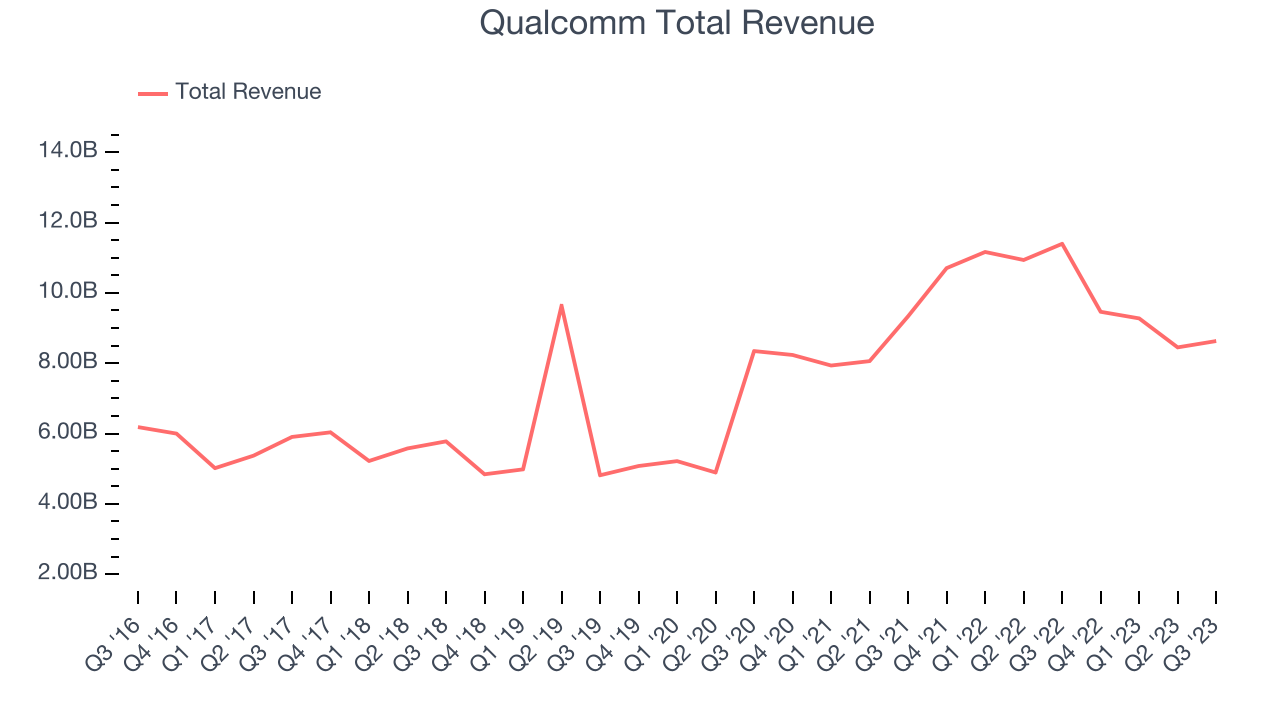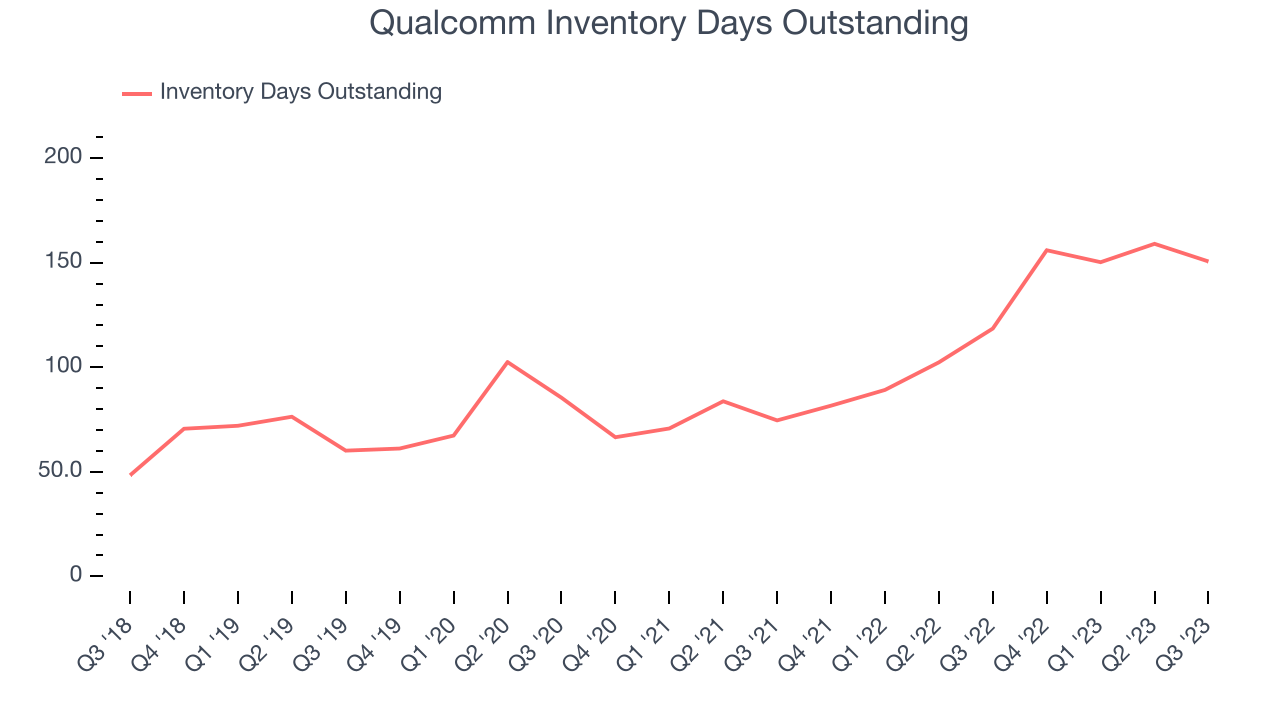Wireless chipmaker Qualcomm (NASDAQ:QCOM) reported Q4 FY2023 results beating Wall Street analysts' expectations, with revenue down 24.3% year on year to $8.63 billion. Guidance for next quarter's revenue was also optimistic at $9.5 billion at the midpoint, 3.36% above analysts' estimates. Turning to EPS, Qualcomm made a non-GAAP profit of $2.02 per share, down from its profit of $2.54 per share in the same quarter last year.
Is now the time to buy Qualcomm? Find out by accessing our full research report, it's free.
Qualcomm (QCOM) Q4 FY2023 Highlights:
- Revenue: $8.63 billion vs analyst estimates of $8.52 billion (1.31% beat)
- EPS (non-GAAP): $2.02 vs analyst estimates of $1.91 (5.93% beat)
- Revenue Guidance for Q1 2024 is $9.5 billion at the midpoint, above analyst estimates of $9.19 billion
- Free Cash Flow was -$298 million, down from $2.35 billion in the previous quarter
- Inventory Days Outstanding: 151, down from 159 in the previous quarter
- Gross Margin (GAAP): 55%, down from 57.3% in the same quarter last year
“As we enter fiscal 2024, we are pleased with our roadmap and product execution, which position us well across our businesses,” said Cristiano Amon, President and CEO of Qualcomm Incorporated. “Our recent Snapdragon Summit announcements underscore our technology leadership, establishing Qualcomm as a leader in on-device generative AI and mobile computing performance”.
Having been at the forefront of developing the standards for cellular connectivity for over four decades, Qualcomm (NASDAQ:QCOM) is a leading innovator and a fabless manufacturer of wireless technology chips used in smartphones, autos and internet of things appliances.
Processors and Graphics Chips
The biggest demand drivers for processors (CPUs) and graphics chips at the moment are secular trends related to 5G and Internet of Things, autonomous driving, and high performance computing in the data center space, specifically around AI and machine learning. Like all semiconductor companies, digital chip makers exhibit a degree of cyclicality, driven by supply and demand imbalances and exposure to PC and Smartphone product cycles.
Sales Growth
Qualcomm's revenue growth over the last three years has been strong, averaging 20.3% annually. But as you can see below, its revenue declined from $11.4 billion in the same quarter last year to $8.63 billion. Semiconductors are a cyclical industry, and long-term investors should be prepared for periods of high growth followed by periods of revenue contractions (which can sometimes offer opportune times to buy).

Even though Qualcomm surpassed analysts' revenue estimates, this was a slow quarter for the company as its revenue dropped 24.3% year on year. This could mean that the current downcycle is deepening.
While most things went back to how they were before the pandemic, a few consumer habits fundamentally changed. One founder-led company is benefiting massively from this shift and is set to beat the market for years to come. The business has grown astonishingly fast, with 40%+ free cash flow margins, and its fundamentals are undoubtedly best-in-class. Still, its total addressable market is so big that the company has room to grow many times in size. You can find it on our platform for free.
Product Demand & Outstanding Inventory
Days Inventory Outstanding (DIO) is an important metric for chipmakers, as it reflects a business' capital intensity and the cyclical nature of semiconductor supply and demand. In a tight supply environment, inventories tend to be stable, allowing chipmakers to exert pricing power. Steadily increasing DIO can be a warning sign that demand is weak, and if inventories continue to rise, the company may have to downsize production.

This quarter, Qualcomm's DIO came in at 151, which is 56 days above its five-year average. These numbers suggest that despite the recent decrease, the company's inventory levels are higher than what we've seen in the past.
Key Takeaways from Qualcomm's Q4 Results
Sporting a market capitalization of $122 billion, more than $11.3 billion in cash on hand, and positive free cash flow over the last 12 months, we believe that Qualcomm is attractively positioned to invest in growth.
We enjoyed seeing Qualcomm exceed analysts' revenue, adjusted operating profit, and EPS expectations this quarter. We were also glad next quarter's revenue and EPS guidance came in higher than Wall Street's estimates, especially when we've noticed weaker guidance among its semiconductor peers. On the other hand, its gross margin decreased. Zooming out, we think this was still a decent quarter, showing that the company is staying on track. The stock is up 3.52% after reporting and currently trades at $114.75 per share.
So should you invest in Qualcomm right now? When making that decision, it's important to consider its valuation, business qualities, as well as what has happened in the latest quarter. We cover that in our actionable full research report which you can read here, it's free.
One way to find opportunities in the market is to watch for generational shifts in the economy. Almost every company is slowly finding itself becoming a technology company and facing cybersecurity risks and as a result, the demand for cloud-native cybersecurity is skyrocketing. This company is leading a massive technological shift in the industry and with revenue growth of 50% year on year and best-in-class SaaS metrics it should definitely be on your radar.
Join Paid Stock Investor Research
Help us make StockStory more helpful to investors like yourself. Join our paid user research session and receive a $50 Amazon gift card for your opinions. Sign up here.
The author has no position in any of the stocks mentioned in this report.
